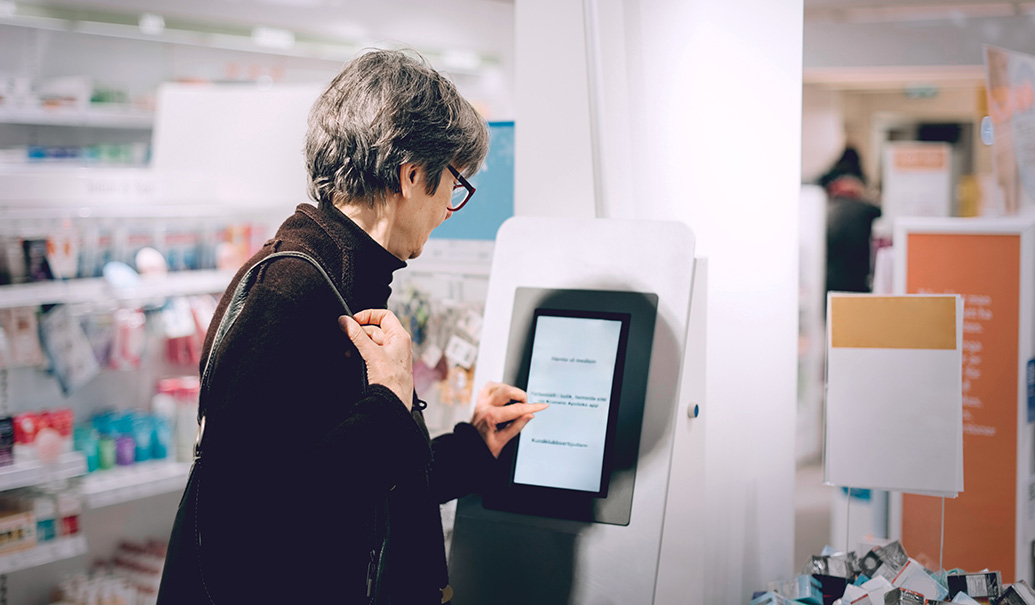Around the world, pharmacies and pharmacists are doing more than dispensing medication. They’ve become part of a destination on consumers’ health journeys. What’s behind this change? Expanding customer expectations, heightened competition and—most visibly—the COVID-19 pandemic.
During the pandemic, pharmacies became consumers’ go-to places for testing and vaccination. As of December 2022, in the U.S., nearly 297 million COVID-19 vaccine doses were administered by retail pharmacies, according to the CDC. In the report “Accessibility of Adult Immunizations in Pharmacies Compared to Physician Offices in Low-income Communities,” researchers from the Global Healthy Living Foundation found that pharmacies offered nearly double the hours for immunizations in low-income communities compared to physician offices in the U.S. That’s not surprising, considering that pharmacies are the most accessible healthcare sites across geographies, with more than 90% of Americans and almost two-thirds of Europeans living within five miles of a community pharmacy.
The industry continues to grow. According to Vision Research Reports, the global pharmacy market size is expected to be worth approximately $1,522B by 2030, up from $1,009B in 2020. The same report noted the retail pharmacy segment held the highest revenue share of 56.2% in 2021.
At the same time, pharmacies are experiencing an accelerated transformation, with a focus on expanding patient care and improving consumer experiences. Regulatory bodies in the U.S. and U.K. are supporting this transformation with guidance and proposed legislation to formalize a valued, supported, integrated and connected pharmacy workforce that can help transform patient care.
To realize their full potential, pharmacies must evolve as easy-to-navigate, one-stop shops that help people manage their health. At the same time, there is an opportunity for them to use relationships and data to support and advance development and delivery of medications to patients, including underserved populations. Biopharma companies can support this evolution and partnership from development to commercialization. Here’s how biopharma companies can seize this moment and create their own efficiencies in cooperation with pharmacies.
3 major shifts in the retail pharmacy industry driving transformation
Driven by changing dynamics ranging from a shortage of healthcare providers to the evolution of complex new therapies and digital healthcare technology solutions, major shifts in the retail pharmacy industry will continue to create transformation.
The shift from dispensing to providing clinical services
Large retail pharmacy chains across geographies are refocusing their service offerings to expand care delivery and patient counselling. For example, in the U.S., CVS, Walmart and Walgreens are transitioning their retail locations into health hubs and expanding their reach into primary care. The U.K.’s LloydsPharmacy chain offers in-store counseling for dementia patients. And in Norway, cardiac patients under the Medisinstart program are offered personal consultations with pharmacists.
In the future, pharmacists will play even more of a role in optimizing patient care and elevating community wellness. Pharmacists have been providing immunizations (such as influenza, diphtheria and tetanus) for more than 20 years. They now offer immunizations for shingles, pneumonia and most recently COVID-19 as well, with possible additions of vaccines for RSV and a combination shot for COVID/influenza on the horizon. As retail pharmacies evolve in this role, they will continue to move beyond dispensing and immunizing to overlap with that of providers and patient advisors. This is especially true in the U.K. and U.S., particularly in areas located at a significant distance from major hospitals or healthcare facilities.
The shift to digital operations and direct-to-consumer models
In a tech-enabled pharmacy, pharmacists can spend more time engaging with patients, rather than doing administrative work. The pandemic pushed pharmacies to build or enhance their digital infrastructure by investing in technologies such as digital messaging, online appointment scheduling and self-service kiosks. Some also added centralized, robot-operated fulfillment centers to improve current business efficiencies and ensure future resilience.
At the same time, customers are increasingly demanding convenient experiences that are delivered via omnichannel and don’t require them to leave their home. Traditionally, the U.S retail pharmacy sector has lagged behind others in retail in its adoption of e-commerce, but it saw a surge in consumer preference for in-home pharmacy care during the pandemic. Other countries saw an e-commerce jump as well. For example, the study “Online Medication Purchasing during the COVID-19 Pandemic: A Pilot Study from the United Arab Emirates” reported one-third of respondents ordered their prescriptions from an online pharmacy.
Business is paying attention. Some online retailers, like Amazon, allow customers (in the U.S.) to buy prescription medications online using cash or insurance coverage. In Indonesia, e-commerce company Tokopedia partnered with online pharmacy aggregator GoApotik to help facilitate online prescription filling and doorstep delivery. Competing with these tech players, CVS in the U.S. has filed a patent to sell virtual goods and nonfungible tokens. In the U.K., Boots is now offering online ordering and drug pickup, an example of the “click and collect model” forecast to double in the next five years. Some E.U. countries like Finland and Estonia are even breaking down borders to allow e-prescriptions issued in one country to be filled at pharmacies in another.
The shift from delivering treatments to offering whole-person care
The pandemic shed light on many disparities in healthcare, leading to a stronger focus on health equity across the industry. While payers, providers and biopharma are introducing initiatives to address health disparities, retail pharmacies are closer to communities, making it easy for them to provide more equitable care. In a study conducted with the Harris Poll, ZS found that in the U.S., patients without health insurance are most likely to choose a pharmacy for primary care.
Accordingly, pharmacies are shifting from condition-oriented treatments to whole-person care, implementing strategies like offering free health screenings, addressing transportation and food security issues, collaborating with providers and other stakeholders to improve outcomes and providing telehealth services. Walmart, CVS and Walgreens are addressing health equity issues, funding and partnering with advocacy groups, community organizations and providers to help transform the cost and convenience of care through education, clinical programs and training. Some smaller retail chains, like Lewis Drug, have also been implementing strategies to address social drivers of health.
How biopharma can support and engage this retail market transformation
Pharmacies are emerging as an important platform consideration for new product development, placement, testing and clinical trial recruitment. By building stronger and more engaged relationships with pharmacies, biopharma manufacturers have an opportunity to reach more customers, improve medication adherence and increase clinical trial diversity and recruitment.
Four considerations for biopharma on this journey:
Rethink who its customers are. Biopharma’s promotional strategies have traditionally targeted physicians. Yet the influence of nonphysician customers across the healthcare ecosystem, such as pharmacists, patients and payers, is increasing in many countries. For many consumers, pharmacies have become primary care destinations. ZS’s research found that younger generations and those without a chronic condition (approximately 20% of 4,000 consumers surveyed) are more likely to choose a pharmacy as their first preference for primary care. ZS also found that across the U.K. and Europe, an average of 13% of respondents say they prefer a pharmacy as their primary healthcare destination.
Pharmacies are emerging as trusted centers for both patients and providers, pushing biopharma to allocate appropriate efforts to reach these new target audiences. In “Diversifying the MSL-KOL Relationships: The Prominent Rise of the Pharmacist KOLs,” an Arx Research study, 51% of life sciences companies said they now target pharmacists for their key opinion leader activities across Asia, Europe, Latin America and North America, leveraging pharmacists’ capabilities to offer early clinical support and later commercial and education support.
Expand the reach of digital therapeutics and digital health tools. In the near future, digital drug companions and digital therapeutics (DTx) will become a standard part of treatment regimens. They may even be used as a first-line therapy, before drugs. With biopharma adopting a patient-first, digital-first approach, pharmacies could prove a valuable site for building adoption of digital health products. They could be leveraged to provide wider awareness, education and access to newer digital health tools and DTx. Some digitally advanced companies, like Roche, have already partnered with Boots pharmacies to promote the mySugr diabetes management app. Pharmacists could help patients identify the most appropriate digital health tools and coach them in their setup, configuration and use. Eventually, they may also be granted access to some point-of-care diagnostics and where regulations allow, the ability to prescribe DTx.
Extend greater and more convenient access to clinical trials. Retail pharmacies have the access, data and opportunities to engage with potential trial participants, putting them in position to support targeted recruitment efforts. Walgreens and CVS are actively taking steps toward expanding recruitment and addressing the need for diversity in clinical trials. It will take time to operationalize these partnerships effectively, but this suggests opportunity for biopharma companies to collaborate with retail pharmacies to expand the number of potential participants, tackling patient access, engagement and retention challenges. CVS has already initiated work with biopharma companies on clinical trial recruitment with the launch of CVS Health Clinical Trial Services. With 40% of vulnerable populations located within five miles of a CVS pharmacy, such projects can open doors to more diverse populations in clinical research.
Enhance patient support services and boost awareness. Biopharma’s patient support services remain underused, due to lack of awareness among patients. For example, “Industry Perspectives: Expanding Awareness of Patient Support Programs,” a study by Phreesia Life Sciences, found that pharma companies spend more than $5 billion on patient support programs, but only 3% of patients are actually using them. Phreesia also found that about one-third of patients are open to learning about support programs from pharmacies. Retail pharmacies can help increase patient awareness and use of these programs, build patient trust in them and enhance customer engagement.
Some biopharma companies, like Novartis and Novo Nordisk, are already collaborating with pharmacies across geographies (such as in Vietnam, Canada and the U.S.) to offer expanded education, disease awareness and coaching support programs for local communities.
This is an opportunity for the sector to leverage the untapped potential of pharmacies, and some biopharma companies are already taking tangible steps to leverage the evolving skills of pharmacists and wider accessibility of pharmacies for better patient engagement.
Outlook: Pharmacies will be dispensing more than medicine
The pharmacies of the future will not look like they do today. They will be dispensing more than medicine— including digital health tools, implants, nutraceuticals and at-home testing kits. By 2030, the majority of pharmacists will transition from transactional care to relationships and responsibilities in advancing patient care. Pharmacies and pharmacists will play an even more prominent role in the consumer’s preventive care journey, overseeing more immunization and early screening services, as well as supporting parts of the traditional patient journey that can be handled locally. As these changes become more commonplace, biopharma organizations can discover new roles within this pharmacy of the future. The time is now to define the right relationships and ways of working with these community-focused healthcare hubs and stakeholders.
Add insights to your inbox
We’ll send you content you’ll want to read – and put to use.















